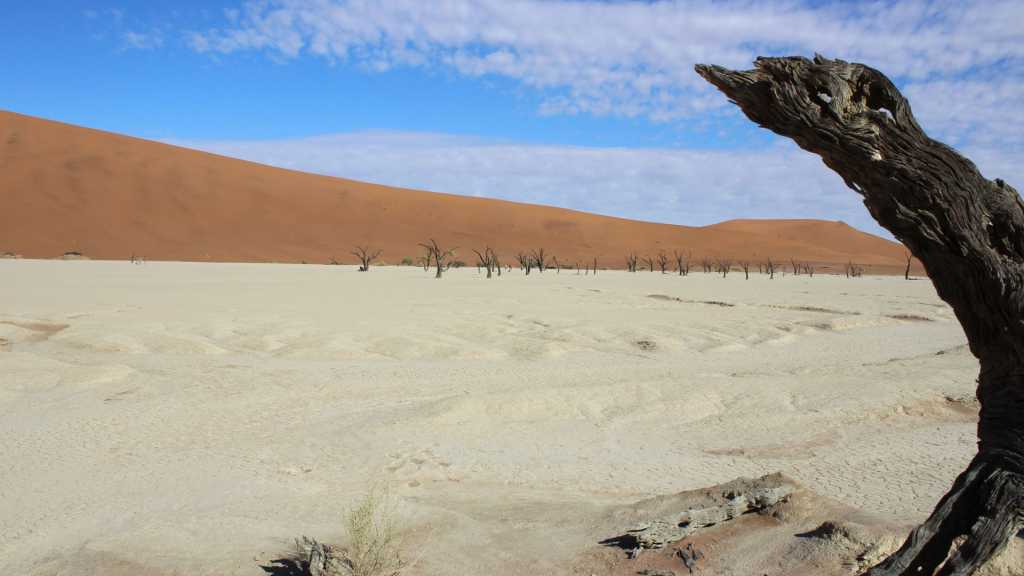The Namib National Park is one of the largest national parks in the world and presents, on nearly 50 000 km2, very varied landscapes: mountainous massifs, gigantic dunes, desert plains. With a changing appearance, the oldest desert in the world unveils new hues at every hour of the day, from off-white to orange and from red to violet, creating fabulous panoramas.
The Sossusvlei dunes: In the heart of the Namib, the dry lake of Sossusvlei is surrounded by dunes some of which are 300 meters high. This is the domain of oryx, springboks and ostriches. Access to the foot of the dunes can only be done in 4x4. Other vehicles park 5 kms from the site and the end of the route is a very pleasant walk of about an hour. Lodges around Sesriem offer excursions to the Sossusvlei dunes by 4x4 vehicule.
Sesriem Canyon: 1 km long and 30 m deep this canyon is, dry, an extraordinary hiking site.
Kuiseb Canyon: north of the park, it marks the boundary between the desert of sand and stone. Formed by the river of the same name, it attracts many mountain zebras and large herds of antelopes.
West of Namibia is entirely turned towards tourism and reserves for its visitor’s epics journeys by road, huge skies and captivating landscapes… It’s the Namibia of our dreams, the one that makes this country to be called the « jewel of Africa ».
A charming seaside resort and top adventure sports venue, Swakopmund is an excellent base for exploring the Skeleton Coast or discovering Walvis Bay and its wildlife…The Namib desert is the Namibian largest natural conservatory and contains a variety of landscapes: the giant Sossusvlei dunes to the majestic Naukluft mountains.
Advices:
- If you can afford, flying over in light aircraft from Swakopmund to Sossusvlei: going inland and flying over Sesriem and going back to the coast will leave you unforgettable pictures and photos...
- If you wish to climb the famous dune "Big Daddy" and enjoy the bird’s eye view of DeadVlei, it’s better to sleep on site or near the entrance of the site… the sun beats hard in the day, the heat is overwhelming, and the lights are never as beautiful as the morning at dawn or late afternoon when the sun goes down
The Great Namibia
Namibia, what else could we ask for? Almost permanent sunshine, great variety of landscapes with wild beauty, national parks rich in fauna and flora. In the West, the Namib desert, the oldest on the planet, the world highest dunes. In the South, the Fish River Canyon, the biggest after the Colorado. In the North, the largest national park in Africa: Etosha. A captivating country with extraordinary natural riches, Namibia deserves its nickname "Jewel of Africa".
When to go?
Subtropical and dry with warm days and cool nights. During the southern summer (from November to March), temperatures vary from 16 to 34°C and in desert areas they can reach 40 to 45°C. In winter (from June to August), they range from 4 to 22℃ and sometimes fall below 0℃ on the relief or in the desert.
The best season to go to Namibia is during the first weeks of November and April. Its not the peak season and the conditions of visit are good. If the high season (May to October) wins the prize of the best climate. Its not necessarily the best because tourists are the most numerous. The rainy season should be avoided if there are plans to explore national parks.
Formalities
The passport must include two blank pages and still be valid for 6 months after the expected date of exit from Namibia. The visa is not compulsory for French nationals. Holders of a French passport are granted tourist visa permits for a maximum of 90 days, which are issued free of charge upon arrival, in particular for immigration checks at Windhoek airport.
For any minor child: a multilingual extract of birth certificate (or an unabridged birth certificate translated into English - certified translation) is required to enter and leave Namibia (in the case of a child traveling with his 2 parents). Please consult the official sites for more information about all the requested documents according to your case.
Health
No vaccination is required for entry into Namibia.
Anti-malarial treatment is recommended (see your doctor). However, it is advisable to check the updating of your usual reminders and vaccinations as for any trip.
Currency
The currency in Namibia is the Namibian dollar (NAD).
Bank cards and traveller’s checks are widely accepted in Namibia, except for the purchase of gasoline especially inside the parks. Major credit cards are accepted in most shops, restaurants and hotels.
Banks and foreign exchange offices make the exchange of your currencies
For your payments, do not hesitate to use the South African rand.
